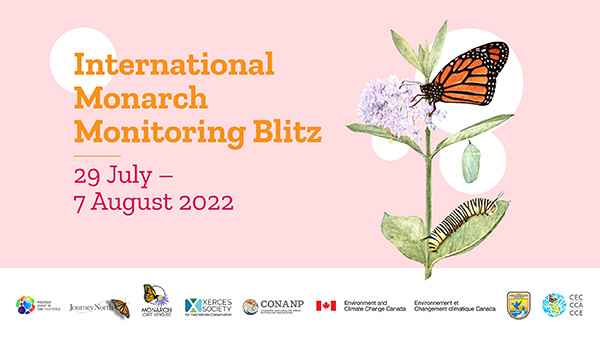From 29 July to 7 August, join the 6th International Monarch Monitoring Blitz!
Montreal, 22 July 2022—Every year, thousands of volunteers in Canada, Mexico and the United States join efforts to support monarch butterfly conservation by collecting observations of monarch butterflies and milkweeds plants! You can contribute to this incredible trinational initiative by sharing your sightings from 29 July to 7 August 2022. With the International Union for the Conservation of Nature recently listing the monarch on its Red List of endangered species, your efforts are vital now more than ever!
During this 10-day period, the International Monarch Monitoring Blitz (the Blitz) invites people across North America to look for milkweed plants and examine them for monarch eggs, caterpillars, chrysalises, and butterflies. Blitz data are uploaded and shared with researchers via the Trinational Monarch Knowledge Network, a central repository that, in combining data from various sources, assists researchers in performing large-scale temporal and spatial analyses. The data collected by volunteers help researchers answer key questions about monarch butterfly and milkweed distribution, timing of reproduction, and the use of natural resources. In turn, this information helps conservationists identify and prioritize actions to conserve the species.
In a rapidly changing world, long-term data are especially important in helping us understand trends in populations and habitat. Our current understanding of the monarch population size is largely driven by overwintering count data, which has shown long-term declines in both the eastern and western migratory populations. Due to the monarchs’ large spatial and temporal range during the summer months, volunteer observations are critical to our understanding of monarch butterflies at this time of year. Blitz data provide the only coordinated trinational snapshot of summer monarch breeding activity, which is important for understanding how successful the breeding population is from year to year.
To take part in the Blitz, share your observations through one of the participating community science programs below:
- Journey North (journeynorth.org)
- Mission Monarch (mission-monarch.org)
- Monarch Larva Monitoring Project (mlmp.org)
- Naturalista (naturalista.mx)
- Western Monarch Milkweed Mapper (monarchmilkweedmapper.org)
Follow the Blitz and share your participation in this international conservation effort on social media by using the hashtag #MonarchBlitz!
The Blitz is organized by the Trinational Monarch Conservation Science Partnership, a collaboration of organizations, including the Commission for Environmental Cooperation, Insectarium/Montréal Space for Life, Environment and Climate Change Canada (ECCC), the Monarch Joint Venture, Journey North, the US Fish and Wildlife Service, the Xerces Society for Invertebrate Conservation, and Mexico’s Comisión Nacional de Áreas Naturales Protegidas (Conanp).
Please visit https://www.cec.org/international-monarch-monitoring-blitz/ for more information about the Blitz.

Illustration courtesy of Biodiversity Heritage Library.
About the CEC
The Commission for Environmental Cooperation (CEC) was established in 1994 by the governments of Canada, Mexico and the United States through the North American Agreement on Environmental Cooperation, a parallel environmental agreement to NAFTA. As of 2020, the CEC is recognized and maintained by the Environmental Cooperation Agreement, in parallel with the new Free Trade Agreement of North America. The CEC brings together a wide range of stakeholders, including the general public, Indigenous people, youth, nongovernmental organizations, academia, and the business sector, to seek solutions to protect North America’s shared environment while supporting sustainable development for the benefit of present and future generations
The CEC is governed and funded equally by the Government of Canada through Environment and Climate Change Canada, the Government of the United States of Mexico through the Secretaría de Medio Ambiente y Recursos Naturales, and the Government of the United States of America through the Environmental Protection Agency.